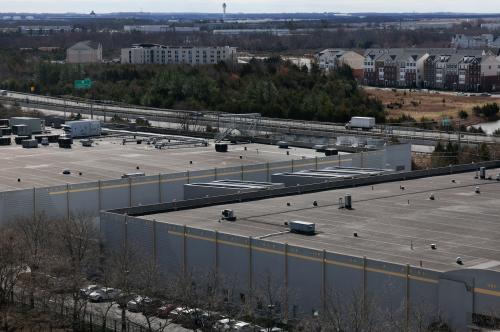Like a microcosm, the contentious 2002 World Summit on Sustainable Development in Johannesburg demonstrated both the broader problems and the promises of global governance. The formal intergovernmental diplomacy of the huge summit produced few tangible results and many disappointments. The political declaration of the 104 heads of state in attendance essentially reconfirmed principles governments had already agreed on a decade ago at the Earth Summit in Rio. Indeed, it took considerable effort to convince a few governments not to reverse some of the accomplishments of the Earth Summit. Yet the Johannesburg negotiations also reflected an ongoing transition to a broader notion of networked governance involving not only governments and international organizations but also businesses and nongovernmental organizations.
The transition—what Jonathan Lash, president of World Resources Institute, has described as a “shift from the stiff formal waltz of traditional diplomacy to the jazzier dance” of issue—based networks and partnerships—is part of a larger phenomenon that has emerged over the past decade. To respond to a wide range of contemporary challenges—from protecting the environment, to fighting diseases such as malaria and AIDS, to implementing labor standards and combating corruption—participants from civil society, business, international organizations, and governments are joining forces in an innovative form of governance: global public policy networks.
New Global Challenges for Governance
Since the early 1990s, the driving forces of globalization—technological change and economic and political liberalization—have fundamentally transformed conditions for effective and legitimate governance.
This new global environment presents four challenges for governance. The first is geographic: decisionmakers in states confront an increasing range of issues that can be addressed only by coordinated cross—border action. The second is temporal and arises directly from rapid technological change. The near—complete integration and 24—hour operation of global financial markets, trade, the media, and many aspects of business severely constrain the time available to traditional public policymakers for weighing options and preparing informed decisions. The third challenge is the steadily growing complexity of public policy issues. Decisionmakers in states and international organizations are having to tackle more and more issues that cut across areas of bureaucratic or disciplinary expertise and whose complexity has yet to be fully understood. The final challenge involves legitimacy and accountability. The traditional closed—shop “club model” of intergovernmental diplomacy cannot fulfill the aspirations of citizens and transnationally organized advocacy groups who strive for greater participation in and accountability of transnational policymaking.
In this new environment, states and international organizations are no longer the only players in the international realm. Nongovernmental organizations and businesses, themselves responding to the pressures of globalization, have reorganized their operations on a transnational scale and are playing a progressively more important role in international relations. More than 40,000 nongovernmental organizations now operate across borders; roughly 60,000 companies have established transnational ties. States, international organizations, companies, and NGOs now find themselves on the same playing field—and are gradually recognizing their interdependence in shaping the environment in which they operate. The new cross—sectoral public policy networks are responding to that interdependence to confront issues that no single sector, public or private, could successfully tackle alone.
Building Bridges
Global public policy networks build bridges across different sectors and levels, bringing together actors from governments, international organizations, civil society, and business.
Unlike traditional hierarchical organizations, these networks are evolutionary in character and flexible in structure. They bring together disparate groups with oftentimes considerably varying perspectives, combining knowledge from different sources in new ways to result in new knowledge.
As they have developed so far, the networks fulfill three primary functions. Some are negotiation platforms that facilitate the setting of global standards and regulations. Others focus on coordinating resources and correcting market failures. Still others focus on implementing existing international treaties.
Negotiation Networks
Global negotiation networks have developed in complex issue areas such as social and environmental reporting and global water management. The World Commission on Dams, for example, developed in response to mounting conflicts among development planners, contracting firms, and environmental groups about dam construction in the late 1980s. The conflict essentially led to gridlock. Governments and international development organizations such as the World Bank were unable to push forward with new dam projects to alleviate water management problems; companies faced an uncertain business environment; and NGOs invested huge resources to keep large dams from being built.
In 1997 the International Conservation Union and the World Bank convened representatives of governments, the private sector, and NGOs to restart the dialogue, leading to the creation of the World Commission on Dams in May 1998. The WCD was charged with developing a catalogue of standards for large—dam construction based on a comprehensive analysis of large dams’ economic, social, political, and cultural ramifications. The commission’s 12 members represented the broad spectrum of stakeholder interests, from multinational construction companies to fierce opponents from the NGO world.
The work of the commission was critically reviewed and supported by a 50—member stakeholder forum, again with representatives from all parties. The commission analyzed the construction of 125 dams and their social and ecological repercussions, undertook numerous local and regional consultations as well as in—depth case studies, and then developed a catalogue of standards and criteria for future dam construction. The catalogue was published in November 2000, and the commission was dissolved the following April. A new institutional structure—the Dams and Development Program—has been created under the leadership of the United Nations Environmental Program to implement the commission’s work.
While the long—term influence of the WCD remains unclear, its work so far has replaced conflict and confrontation with cooperation and dialogue. But progress was halted when the World Bank, once a strong supporter, announced that it would not recognize the published WCD standards and recommendations as binding for its lending operations. As a result, NGOs are mobilizing to return to the status quo ante. A major breakdown of the post—WCD implementation process would damage similar initiatives in other issue areas. Still, even though the Bank does not officially recognize the standards as binding, its lending practice shows that it cannot ignore the WCD standards.
Thus far, at least, the overall work of the WCD has been deemed a success. Through an inclusive and transparent process, the commission managed to transcend highly volatile and politically sensitive conflicts and to channel social conflict into a productive cross—sectoral dialogue with concrete results. Through extensive consultation and parallel research projects, the commission managed to link the global deliberation process to regional as well as local levels. A balanced approach in financing its work, with equal contributions from foundations, companies, and the public sector, has ensured the impartiality and legitimacy of the WCD to this very day.
Coordination Networks
Coordination networks develop joint plans for action, usually in improving the allocation of scarce resources and correcting market failures in different issue areas.
The Global Water Partnership (GWP), guided by a small secretariat in Stockholm, collects and disseminates best practices and lessons learned in integrated water management programs. Its central goal is to join all stakeholders from civil society, the private sector, and the public sector into “water partnerships” on the local, national, regional, and global levels. Since its creation in 1996, it has established several regional and almost 20 national water partnerships in Central America, China, South East Asia, and South America, as well as West Africa. Representatives from the private sector, governments, and civil society serve on its board. Funding comes primarily from public sources but also from the Ford Foundation, the UN Development Program, and the World Bank.
The Roll Back Malaria initiative (RBM) was created in 1998 at the behest of the World Health Organization to better coordinate the fight against malaria, which causes at least 300 million cases of acute illness each year and is the leading cause of death in young children. The initiative’s declared goal is to halve malaria—induced mortalities by 2010 by using more effectively the comparative advantages of each actor in the fight.
This new approach is the result of a long and difficult learning process. Over the past 50 years, various international groups have entered the fray, as the problem worsened because of the increasing resistance of malaria vectors, the shift of malaria—endemic regions as a result of global climate change, and increased travel and migration. By the end of the 1990s, the failure of traditional hierarchical approaches had prompted new thinking in the world’s health and development communities. Today RBM combines many groups under a single network roof. Companies such as Novartis, ExxonMobil, GlaxoSmithKline, and Procter & Gamble are working with NGOs such as Oxfam and the International Federation of the Red Cross, with several national governments lending financial support. The World Health Organization coordinates the work, with other UN agencies and international organizations also contributing.
Another coordination network, the Medicines for Malaria Venture (MMV), improves the economic incentives for pharmaceutical companies to develop badly needed antimalarial vaccines. Contributors include the Global Forum for Health Research, the Rockefeller Foundation, SmithKline Beecham and Wellcome Trust, and the United Kingdom Department for International Development. Research and development is funded primarily by the public sector and private foundations, creating a more predictable business environment for the pharmaceutical companies that have committed expertise and resources.
Implementation Networks
A final group of networks is dedicated to providing innovative mechanisms for implementing intergovernmentally negotiated treaties. The Global Environmental Facility (GEF), established in 1991, is an early example of a cross—sectoral financial mechanism through which civil society and business implement international agreements on biodiversity, climate change, and persistent organic pollutants.
More recently, the “Clean Development Mechanism” (CDM) and “Joint Implementation” (JI) have been established to help implement the Kyoto protocol on climate change by making use of pollution trading permits. Developing countries and industrialized countries join forces in both CDM and JI, which are designed to scale up cooperative climate—protection projects in fields such as renewable energies, waste management, and carbon sequestration. Developing countries receive financial and other support in the form of foreign direct investment and projects that promote sustainable development; industrialized countries can count certified emission reductions generated by such projects toward their emission accounts established under the protocol. The goal is to create new incentives for investment in climate—friendly technologies and to open new channels for technology transfer to the developing world. Both JI and CDM projects offer new venues for the private sector and civil society to participate in climate—protection projects. The projects typically bring together one or more countries committed to reduce emissions under the Kyoto protocol, companies from these countries that wish to buy emission reductions, a host country that approves the project and the purchase of trading permits, and a project developer (a company or an NGO).
NGOs can help design projects and implement them on the local level, serving as watchdogs and helping tailor projects to community needs. Cooperation between the public sector, companies, and NGOs on global warming is often highly charged, however, complicating further the work of these networks in promoting sustainable development.
Management Challenges
Networks do not offer a free lunch. They are complex political animals that require much political skill and leadership to be successful and sustainable in the long term. As with any new form of governance there is no shortage of crucial shortcomings and challenges, which critics have pointed out in recent years and which networks have already responded to in various ways.
Although the degree of inclusion of stakeholders is critical to a network’s legitimacy, large numbers of participants may result in sizable, sometimes prohibitive, transaction costs. Furthermore, mutual dependence and long—term interaction may lead networks to develop into closed shops. And the need for compromise and consensus might favor the lowest common denominator as the eventual policy outcome. At the same time, networks’ informal structure and reliance on consensus may offer decision blockades and veto positions for even their smallest actors.
Global public policy networks have been criticized most often—and on most fronts—for unequal access and power. Many in the developing countries believe the networks are dominated by the industrialized nations, whose corporate and civil society interests further weaken the already feeble voices of the poor countries. Other critics castigate the network approach for its “power blindness” and its naivete in the face of huge power disparities in the global arena. Parliamentarians also often feel bypassed by networks in which representatives from the executive branch mostly take the lead. Finally, some
critics have noted in these networks a tendency to act as talk—shops that consume resources—tangible as well as intangible—without delivering adequate results.
All these issues must be addressed to mainstream cross—sectoral networks in global policymaking. It is promising that a number of networks have found innovative ways of dealing with these complicated issues, such as balancing representation or transparency requirements.
Learning by Doing
In his Millennium Report, UN Secretary—General Kofi Annan noted that “if we are to get the best out of globalization and avoid the worst, we must learn to govern better, and how to govern better together. . . . We must form coalitions for change, often with partners well beyond the precincts of officialdom. . . . Mobilizing the skills and other resources of diverse global actors, therefore, may increasingly involve forming loose and temporary global policy networks that cut across national, institutional and disciplinary lines.” Cross—sectoral networks are a promising means to improving global governance. But much remains to be done if the networks are to live up to their potential. Three tasks are central.
The first is to mainstream cross—sectoral networking by promoting organizational change. The UN and the World Bank have declared their intention of making partnerships and “coalitions for change” a central part of their strategic orientation. But the involvement of international organizations in partnerships remains scattered, and public institutions often lack a coherent strategy to incorporate partnerships into their “normal” way of doing business (as do many businesses and NGOs).
Increased involvement by multilateral institutions will require big changes in their organizational structures and cultures. It will also require fundamental change on the side of their stakeholders—governments of their member states. Networks and partnerships are meant to complement, not replace, national governments. They are not intended to let governments “off the hook.” States must be willing to invest substantial resources into these new forms of governance. In return, networks can help states and their international organizations achieve their missions, maintain their competence, and serve their citizens.
The second task is to strengthen network accountability. While a binding legal framework for cross—sectoral networking is neither realistic nor desirable, it is possible to devise ground rules that foster the accountability of network participants and processes.
The final task is to build capacity through a learning forum. One way to make the most of these new forms of governance is to create a “learning forum” to connect work being done on cross—sectoral collaboration in think tanks, NGOs, companies, international organizations, and public—sector agencies. The learning forum should bring together the rigor of policy analysts and the wealth of experience of network practitioners to discuss best practices and lessons learned. It could devise ways to scale up networks’ experience, increase their resources, and monitor and evaluate their work. It could also provide training services for networks.
The past decade has been a period of ferment and experimentation with new cross—sectoral forms of governance in global policymaking. In many ways, practice can now inform theorizing. Global public policy networks require political leadership, organizational reform on the part of all involved, and the commitment of real resources. Given the magnitude of governance challenges we are facing today, we need to make sure to capitalize on the rich experience of cross—sectoral networks and fully put them to work for improving global governance.
The Brookings Institution is committed to quality, independence, and impact.
We are supported by a diverse array of funders. In line with our values and policies, each Brookings publication represents the sole views of its author(s).



Commentary
Global Public Policy Networks: Lessons Learned and Challenges Ahead
March 1, 2003